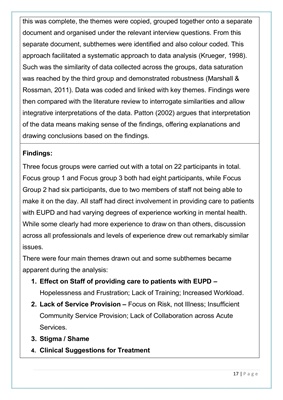
17 | P a g e
this was complete, the themes were copied, grouped together onto a separate
document and organised under the relevant interview questions. From this
separate document, subthemes were identified and also colour coded. This
approach facilitated a systematic approach to data analysis (Krueger, 1998).
Such was the similarity of data collected across the groups, data saturation
was reached by the third group and demonstrated robustness (Marshall &
Rossman, 2011). Data was coded and linked with key themes. Findings were
then compared with the literature review to interrogate similarities and allow
integrative interpretations of the data. Patton (2002) argues that interpretation
of the data means making sense of the findings, offering explanations and
drawing conclusions based on the findings.
Findings:
Three focus groups were carried out with a total on 22 participants in total.
Focus group 1 and Focus group 3 both had eight participants, while Focus
Group 2 had six participants, due to two members of staff not being able to
make it on the day. All staff had direct involvement in providing care to patients
with EUPD and had varying degrees of experience working in mental health.
While some clearly had more experience to draw on than others, discussion
across all professionals and levels of experience drew out remarkably similar
issues.
There were four main themes drawn out and some subthemes became
apparent during the analysis:
1. Effect on Staff of providing care to patients with EUPD -
Hopelessness and Frustration; Lack of Training; Increased Workload.
2. Lack of Service Provision - Focus on Risk, not Illness; Insufficient
Community Service Provision; Lack of Collaboration across Acute
Services.
3. Stigma / Shame
4. Clinical Suggestions for Treatment